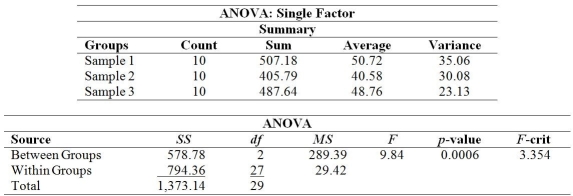A manager is interested in testing whether three populations of interest have equal population means.Simple random samples of size 10 were selected from each population.The following ANOVA table and related statistics were computed:  Conduct the appropriate test of the null hypothesis assuming that the populations have equal variances and the populations are normally distributed.Use a 0.05 level of significance.
Conduct the appropriate test of the null hypothesis assuming that the populations have equal variances and the populations are normally distributed.Use a 0.05 level of significance.
Definitions:
Diversified Investor
An investor who spreads their investment across various assets to minimize risk.
Risk Premium
The additional return an investor demands for taking on a higher risk compared to a risk-free investment.
Non-diversifiable Risk
The part of an investment's risk that cannot be eliminated through diversification, pertaining to wider market or economic factors.
Systematic Risk
The peril present throughout an entire market or a portion of the market that cannot be alleviated by spreading investments.
Q4: An advertising company has developed a new
Q30: The null hypothesis that two population variances
Q39: A study was recently conducted in which
Q41: Which of the following regression output values
Q64: A stockbroker at a large brokerage firm
Q69: Recently,a manager for a major retailer computed
Q82: It is believed that the number of
Q88: Forecast bias measures the average amount of
Q94: A study was recently conducted in which
Q170: When testing a two-tailed hypothesis using a